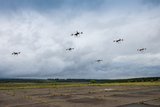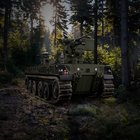Europe's focus on unmanned network centric solutions to boost the UGV market
The European unmanned ground vehicles (UGV) market is growing slowly, but steadily, depicting a relatively undisturbed trend for the year 2011 and beyond. The United States has progressed in terms of the network enabled capability of their defence resources, spurring the Departments of Defence (DoDs) of various European countries to focus on unmanned network centric solutions.
Currently, soldier force modernisation is on the agenda of several European countries, to retain their technological edge over developing nations. The gap between US and European defence technology is an additional instigating factor. UGV is becoming an integral part of network centric warfare.
New analysis from Frost & Sullivan, Unmanned Ground Vehicles Market Assessment - Europe, finds that the market earned revenues of $302.5 million in 2009 and estimates this to reach $311.2 million by 2016.
"Network enabled capabilities are gradually gaining momentum within the Ministries of Defence (MODs)," says Frost & Sullivan Research Analyst Shyam Srinivasan. "The ability of remotely patrolling a group of vehicles and strategising battlefield formations has evoked an interest to graduate to unmanned artillery in the future."
The European UGV industry has remained niche. The future lies in opening up opportunities for smaller participants to penetrate the market. Another potential is in the maintenance and repair of such specialised machinery in the period from now to 2016.
However, reduced defence budget allocation is one of the primary restraints to the UGV market. Furthermore, lean expenditure on new technology is to support the production of traditional weapons for the Afghan war.
"The unit cost of the equipment is also a restraint to procurement in numbers," explains Srinivasan. "For example, a small unmanned ground vehicle (SUGV) with electro-optics/infrared (EO/IR) sensors would cost about $20,000 and the cost of explosive ordnance disposal (EOD) machinery can go up to $300,000."
The industry should focus on the commercial and civil market to increase revenue. The lower unit cost can be attained by using less expensive materials and technologies. Progress towards expendable equipment will result in manufacturing affordable equipment.
"Civil security and border patrol to tackle improvised explosive devices (IEDs) are some of the potential areas to focus on for greater revenue in the long-term," concludes Srinivasan.
Source: Frost and Sullivan
More from Uncrewed Vehicles
-
![US Navy foresees an uncrewed future for its surface and underwater fleet]()
US Navy foresees an uncrewed future for its surface and underwater fleet
The service has been conducting various procurement and development efforts to integrate unmanned surface and underwater vehicles into its inventory.
-
![Tekever unveils new swarm-controlling UAS]()
Tekever unveils new swarm-controlling UAS
Tekever has manufactured the AR3, AR4 and AR5 UAS with all systems sharing common electronics and software architecture, which has enabled the reuse of ground segment elements within the new ARX UAS.
-
![Ready for the race: Air separation drone swarms vs. air defence systems]()
Ready for the race: Air separation drone swarms vs. air defence systems
As the dynamics of aerial combat rapidly evolve, Chinese scientists have engineered a sophisticated air separation drone model that can fragment into up to six drones, each capable of executing distinct battlefield roles and challenging the efficacy of current anti-drone defences such as the UK’s Dragonfire laser system.
-
![Israel’s MALE UAVs ‘must adapt’ to Iranian-made air defences]()
Israel’s MALE UAVs ‘must adapt’ to Iranian-made air defences
Advancements in air defence technologies have begun to reshape aerial combat dynamics in the Middle East, as illustrated by recent events involving the Israeli Air Force and Hezbollah.
-
![Hundreds more UAS sent to Ukraine forces with thousands more on the way]()
Hundreds more UAS sent to Ukraine forces with thousands more on the way
Both sides of the Russia-Ukraine war have been using UAS for effective low-cost attacks, as well as impactful web and social media footage. Thousands more have now been committed to Ukrainian forces.
-
![AI and software companies selected for US Army Robotic Combat Vehicle subsystems]()
AI and software companies selected for US Army Robotic Combat Vehicle subsystems
The US Army has intentions to develop light, medium and heavy variants of the Robotic Combat Vehicle (RCV) as part of the branche’s Next Generation Combat Vehicle family.
























